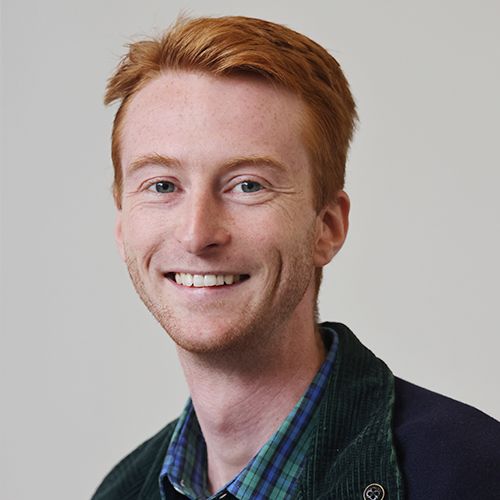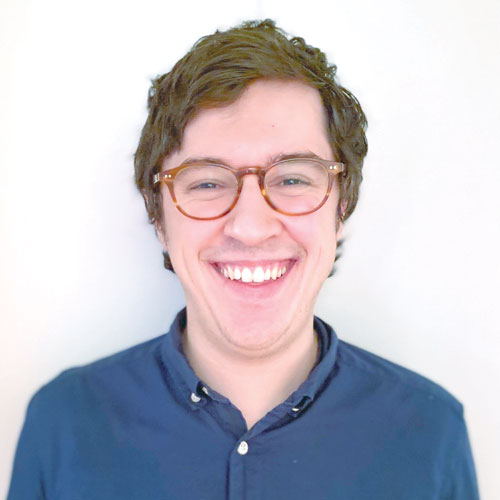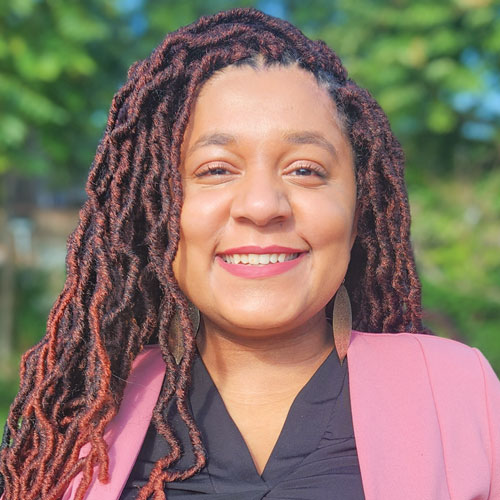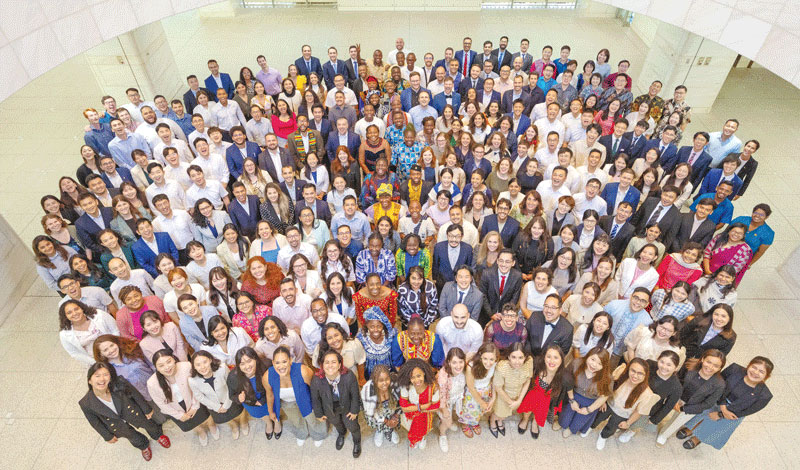TOKYO—With the determination to carry on their mentor’s legacy, some 260 youth representing 60 countries and territories gathered from June 26 to July 2 in Tokyo for the first SGI Youth Training Course since Ikeda Sensei’s passing. In this feature, the World Tribune highlights activities and impressions from the 18 youth who represented the SGI-USA.
Click here to watch a video of the training course produced by the Seikyo Shimbun.
Thursday, 6/27
Opening Ceremony and Study Session at the Soka Bunka Center
At the opening ceremony, SGI Senior Vice President Yoshiki Tanigawa began with an experience from his youth.[1] As the newly appointed young men’s leader in 1990, he received guidance from Ikeda Sensei, which in essence was: If youth fail to wage a life-or-death struggle to advance kosen-rufu, their spirit will be lost. It is faith that is important.
Through his experience, Mr. Tanigawa clarified the essential qualities of a leader: a sense of responsibility and taking the lead at the forefront. In addition, he touched on the importance of study in leading the way and presented 15 passages from the writings of Nichiren Daishonin for the participants to engrave in their lives.[2] He concluded by calling on the youth to fight through every struggle and create an SGI organization that Sensei would be proud of.
Following this, a study session was led by Soka Gakkai Study Department Leader Seiichiro Harada. Beginning with Sensei’s guidance on the importance of engaging with Nichiren’s writings, he centered his study on two lectures from Sensei’s study series “The Buddhism of the Sun—Illuminating the World.”[3]
Within these lectures, Mr. Harada highlighted Sensei’s guidance on the key topics of transforming great evil into great good and becoming individuals who are respected and praised by others in society.

Krithi Byadgi (San Francisco Ever-Victorious Zone Young Women’s Leader): I heard how Sensei lived each moment to the fullest and poured everything into each encounter throughout his life. Learning about mentor and disciple this time, I realized it wasn’t about imitating him but about awakening to the preciousness of my own life and striving each day, regardless of any difficulties.
Friday, 6/28
Tour of Kanagawa Culture Center and Hall of the Great Vow for Kosen-rufu
The next day, the SGI-USA representatives visited the Kanagawa Culture Center—the place where Sensei embarked in earnest on a journey to accomplish worldwide kosen-rufu after stepping down as Soka Gakkai president on April 24, 1979, to shield the members from the corrupt and authoritarian Nichiren Shoshu priesthood.[4]
During a tour, the representatives learned how, during this crucial period, Sensei often took walks around the center and engaged one to one with local residents. Despite the various restrictions placed on him by the Nichiren Shoshu priesthood, his spirit remained the same: to treasure each person he encountered.
Afterward, all participants made their way to the Hall of the Great Vow for Kosen-rufu to do gongyo and hear words from Soka Gakkai General Director Shigeo Hasegawa.

Max Heine (Los Angeles Pan-Pacific Zone Young Men’s Leader): The Kanagawa Culture Center isn’t a “holy” place, rather it’s defined by what Sensei did there: relentlessly meeting with one person after another to encourage them. When I saw all the youth representatives from around the world gathered at the Hall of the Great Vow for Kosen-rufu, it was so clear what he had accomplished, starting from Kanagawa. Sensei had won.
Saturday, 6/29
Third Soka Gakkai Headquarters Leaders Meeting at the Tokyo Toda Memorial Auditorium
In conjunction with the training course and various commemorative meetings, the Third Soka Gakkai Headquarters Leaders Meeting Toward Our Centennial was held at the Tokyo Toda Memorial Hall. At this hall, a portrait of Sensei was displayed for the first time alongside those of Soka Gakkai presidents Tsunesaburo Makiguchi and Josei Toda.
The meeting, planned entirely by the Soka Gakkai youth, incorporated festive performances and the future and student division members. In his opening words, Soka Gakkai Senior Vice President Hiromasa Ikeda unveiled Sensei’s calligraphies “Twenty-First Century” and “Courageous Dance” that reflected his trust in the youth of Soka.
Then, five representatives shared their determinations, among them SGI-USA Young Men’s Leader Shota Okajima. He reported on the recent March Youth Peace Festivals and determinations toward a victorious Summer of Shakubuku.
Following this, Soka Gakkai President Minoru Harada spoke of his recent meeting with Pope Francis and on nurturing individuals with genuine faith (see p. 10 of this issue). The meeting concluded with a video of Sensei’s speech from 2002 (see p. 9 of this issue).

David Drake (New York Zone Young Men’s Leader): From the performances, to the reports from the youth representatives from around the world, to the behind-the-scenes movement, everything emanated this incredible life force. I felt that world peace was possible—this is what it looks like, and this is the group that will make it happen.
Sunday, 6/30
Exchange Meetings at the Tokyo Toda Memorial Auditorium
In the morning, an exchange meeting with future division members was held. Future division members took on various roles in the meeting, such as guiding each of the training course participants to their seats and singing the song “Eternal Journey With Sensei” in English—a performance that took months to prepare.
The key activity was a Q&A session, where the future division members asked the training course participants about pursuing their dreams, managing busy schedules and more.
Following this, was another exchange meeting with local youth and their guests. It kicked off with cultural performances and the debut of the new SGI-USA youth song, “Striving for Peace.”[5] Four members then shared a joint experience about how one person introduced the other to Buddhism, who then introduced the next.
The training course participants went on to engage with the local youth members and guests. In total, some 4,700 youth, 500 of them guests, participated in the two exchanges. Inspired by this meeting, 15 youth joined the Soka Gakkai that day.

Jackie Alexander (Chicago South Region Young Women’s Leader): Future division members openly asked questions about their struggles in front of hundreds of people from around the world. People often associate younger people with shyness, but I saw how sincere and confident youth can grow when they have experiences like this in our “garden of Soka.”
Monday, 7/1
Guidance Sessions and Closing Ceremony
The final day opened with divisional guidance sessions where the participants could ask SGI youth leaders questions about faith, leadership and supporting the members.
In the closing ceremony, SGI Youth Leader Mitsuo Nishikata thanked everyone for their efforts. On returning home, he called on them to stand up with the vow to advance kosen-rufu in their respective countries and territories. He announced the new motto “One World, With Sensei” toward changing the destiny of humankind.
Concluding the training course was a guidance session with President Harada. He touched on the significance of the second and third series of the Seven Bells[6] spanning the 21st century, in which Sensei envisioned the people-centered life philosophy of Nichiren Daishonin to become a global ethos and the spirit of the age.
President Harada pointed out that 2024 marked the midpoint of this current set of Seven Bells toward 2050 and was thus a turning point in our efforts to usher in a new era of worldwide kosen-rufu. He encouraged everyone to share in this mission bequeathed by Sensei and set out, working solidly, steadily and patiently, while engaging in dialogue with Sensei in our hearts along the way.
August 2, 2024, World Tribune, pp. 6–8
References
- See September 2024 Living Buddhism, pp. 23–25. ↩︎
- See ibid., pp. 26–27. ↩︎
- See July 2021 Living Buddhism, pp. 53–62, and October 2021 Living Buddhism, pp. 53–62. ↩︎
-
First priesthood issue: Nichiren Shoshu priests conspired with a corrupt Soka Gakkai lawyer to attack Ikeda Sensei and the Soka Gakkai’s members, seeking to gain control over the organization’s assets. On April 24,1979, Sensei stepped down as Soka Gakkai president to protect the members from further persecution. ↩︎
- See July 19, 2024, World Tribune, p. 9. ↩︎
- Seven Bells: The first series of Seven Bells are seven consecutive seven-year periods in the Soka Gakkai’s development from its founding in 1930 through 1979. On May 3, 1966, Sensei spoke of a new series of Seven Bells that he envisaged unfolding in the 21st century. He later extended this to comprise a total of seven series of Seven Bells to the middle of the 23rd century. ↩︎
You are reading {{ meterCount }} of {{ meterMax }} free premium articles

